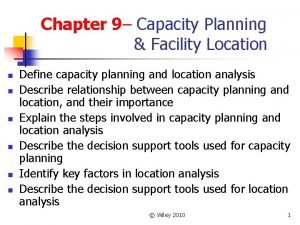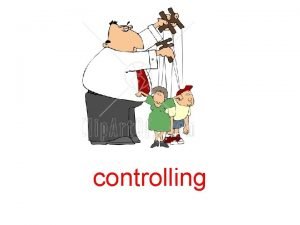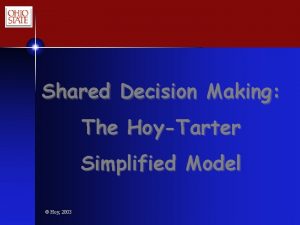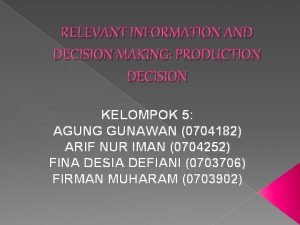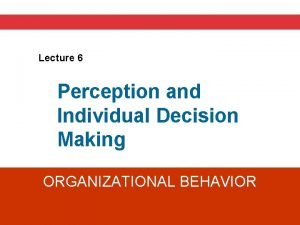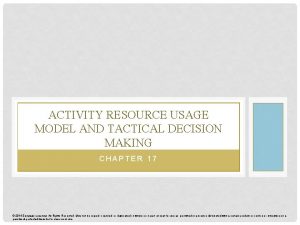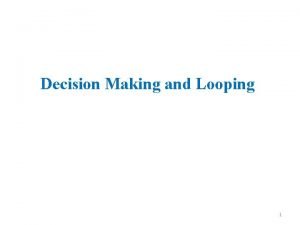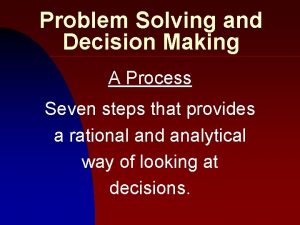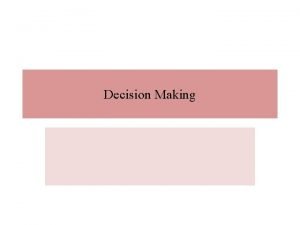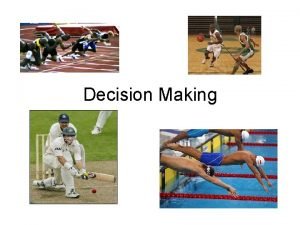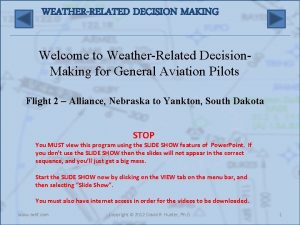MONITORING MODELING AND DECISION MAKING MAKING IT WORK















![RESULTS [TP] [TKN] [TSS] E. coli Temperature TP load TKN load TSS load -15% RESULTS [TP] [TKN] [TSS] E. coli Temperature TP load TKN load TSS load -15%](https://slidetodoc.com/presentation_image_h/2f66afa308afeee9597ca45b48f14a8b/image-16.jpg)



























- Slides: 43

MONITORING, MODELING AND DECISION MAKING: MAKING IT WORK Thomas E. Davenport, USEPA Donald W. Meals and Steven A. Dressing, Tetra Tech, Inc.

Monitoring • Major component of water quality management • Provides essential data about the resource • Can be expensive and challenging • Requires careful design and execution to achieve objectives

Monitoring Several major watershed monitoring projects have reported little or no improvement in water quality after extensive implementation of best management practices (BMPs) in the watershed: • Uncooperative weather • Improper selection of BMPs • Mistakes in understanding of pollution sources • Poor experimental design • Lag time

Monitoring Increased integration of fragmented environmental monitoring efforts to improve the collection, analysis, and reporting of data: • Strategic assessment of objectives • Focus on utility of resulting data 2006. Filling the gaps: Priority Data Needs and Key Management Challenges for National Reporting on Ecosystem Conditions

Modeling • • Forecasting Evaluating potential alternatives Requires data Application in the absence of observed data is problematic • Skepticism and uncertainty can compromise utility for watershed planning

Modeling SPARROW Predicts contaminant flux, concentration, and yield in streams http: //water. usgs. gov/nawqa/sparrow/ Used to evaluate alternative hypotheses about the important contaminant sources and watershed properties that control transport over large spatial scales. Disputes or misunderstandings over modeled vs. measured pollutant loads in economic and political conflicts over source identification and choices of potential actions for remediation

Modeling Chesapeake Bay Watershed Model Bay Pollution Progress Overstated Government Program's Computer Model Proved Too Optimistic By Peter Whoriskey Washington Post Staff Writer Sunday, July 18, 2004; Page A 01 Senators call for GAO review of Chesapeake Bay Program (AP) - Three U. S. senators, including Virginia's John Warner, have asked for a review of the EPA's Chesapeake Bay Program following reports that the federal agency directing bay restoration efforts has overstated environmental achievements. http: //www. chesapeakebay. net/model. htm

Role of Monitoring • • Identify problems Establish baseline conditions Document change Assess program/project effectiveness Inform stakeholders Assess compliance Provide information/data to support models

Role of Monitoring • Data that document water quality improvement lend credibility to project planning and implementation • Information relevant to stakeholders • Measurement of actual watershed conditions is powerful tool for changing behavior

Monitoring challenges Design problems ü Failure to measure what is needed ü Inadequate problem identification ü Misunderstanding of the system being monitored ü Statistically weak design L. M. Reid. 2001. The epidemiology of monitoring. J. AWRA 37(4): 815 -820.

Monitoring challenges Procedural problems ü Failure to evaluate data regularly ü Lack of collateral information ü Poor institutional integration ü Bad or misunderstood technology ü Staffing and training L. M. Reid. 2001. The epidemiology of monitoring. J. AWRA 37(4): 815 -820.

Monitoring challenges • Procedural problems can sabotage even a well-designed monitoring program • Procedural problems can be corrected with good management, training, and resources • Flawed design can doom a monitoring program from the start

Examples of effective watershed monitoring from the USEPA National Nonpoint Source Monitoring Program

VT NMP Project 1993 - 2001 Evaluate effectiveness of livestock exclusion, streambank protection, and riparian restoration in reducing runoff of nutrients, sediment, and bacteria from agricultural land to surface waters

§ Paired watershed design § Continuous discharge § Flow-proportional automated composite sampling (weekly) üTotal Phosphorus (TP) üTotal Kjeldahl Nitrogen (TKN) üTotal Suspended Solids (TSS) § Bi-weekly grab sampling ü Indicator bacteria ü Temp. , conductivity, D. O. § Annual biomonitoring ü Macroinvertebrates ü Habitat ü Fish § Annual land use/management
![RESULTS TP TKN TSS E coli Temperature TP load TKN load TSS load 15 RESULTS [TP] [TKN] [TSS] E. coli Temperature TP load TKN load TSS load -15%](https://slidetodoc.com/presentation_image_h/2f66afa308afeee9597ca45b48f14a8b/image-16.jpg)
RESULTS [TP] [TKN] [TSS] E. coli Temperature TP load TKN load TSS load -15% -12% -34% -29% -6% -49% -38% -28% -800 kg/yr -2200 kg/yr -115, 000 kg/yr Macroinvertebrate IBI improved to meet biocriteria No significant change in fish community

OR Upper Grande Ronde NMP Project 1995 - 2003 Improve salmonid community through restoration of habitat and stream temperature regime Document effectiveness of channel restoration on water temperature and salmonid community

§ Before/after channel restoration, with control § Continuous air & water temperature, periodic habitat assessment, snorkel surveys for fish monitoring

RESULTS § Cooler water temperatures in pools and deeper runs § Reduced width-depth ratios compared to unrestored reaches § Rainbow trout numbers control before after increased in restored reaches, while constant or decreasing in unrestored and control reaches

Monitoring requirements • Understanding of WQ problems, pollutants, and sources; • Clear monitoring objectives; • Specific experimental design that controls for weather, land use, and other external factors; • Where, when, how, and how often samples will be taken; • How samples will be analyzed; • How the resulting data will be stored, retrieved, analyzed, and interpreted; and • How the results will be communicated

Role of Modeling Planning = making informed choices about which path to take toward the future Modeling: Tools for visualizing potential results during the planning process Means to forecast the likely impacts of alternative management options

Role of Modeling Screening • Initial estimates of flow and pollutant loads • Guide for monitoring Characterization • Link sources to water quality impacts • Evaluate relative magnitude of sources

Role of Modeling Land Treatment • Simulate pollutant transport processes • Identify critical areas • Predict pollutant reductions • Analyze effectiveness and cost of alternatives Waterbody response Guide monitoring programs • Testable hypotheses • Establish monitoring locations, frequency, etc.

Role of Modeling Predict future water quality changes to estimate time required to achieve results from watershed treatment programs, i. e. , lag time. 40 – 50 yrs 10 yrs

Modeling challenges • Data required ü Setting model parameters ü Calibration ü Validation • Technical and financial resources required

Modeling challenges • May be impaired by inappropriate or outdated data ü Soil surveys ü Curve number ü TR-55

Modeling challenges • Model results require analysis and interpretation to be useful

Modeling challenges Use of models cannot replace monitoring, especially for project evaluation. The most convincing evidence of watershed project effectiveness is actual measurement of conditions in the watershed and in the water body

Examples of effective use of modeling from the USEPA National Nonpoint Source Monitoring Program

Warner Creek, MD Demonstrate cropland BMP effectiveness and determine parameters for SWAT model for application to similar watersheds elsewhere in the state

Peacheater Creek, OK Used SIMPLE (Spatially Integrated Models for Phosphorus Loading and Erosion) to identify high-risk P sources in watershed to design land treatment plan

Otter Creek, WI BARNY model used to supplement site assessment to rank critical dairies based on phosphorous loadings from animal confinement areas.

Integrating Monitoring & Modeling Monitoring and modeling are not mutually exclusive. Each tool has strengths and weaknesses. Neither by itself can usually provide all of the information needed for water quality decision-making.

Integrating Monitoring & Modeling Monitoring Real evidence of water quality impairment Best evidence of water quality restoration Modeling Extend apply the knowledge Forecast future response to alternatives

Integrating Monitoring & Modeling Monitoring Fundamental knowledge about generation, fate, and transport of nonpoint source pollutants Modeling Means to assemble, express, and test current state of understanding

Integrating Monitoring & Modeling Evaluation of model results Improve model Guide additional monitoring

Integrating Monitoring & Modeling Adaptive management Systematic process for continually improving management approaches by learning from the outcomes of the BMPs having been installed

Recommendations Use the strengths of both – Simulations and extrapolations must not replace on-the ground monitoring – Modeling can provide guidance on where and how the on-the-ground monitoring is best conducted – Monitoring cannot practically compare numerous scenarios or extrapolate effects far into the future – Data collected through monitoring is essential for calibration and validation of models.

Recommendations Start from objectives, not budget – Models selected by cost before setting objectives are unlikely to meet needs – A monitoring program based solely on budget may collect too few samples, too infrequently, yielding data that cannot serve project objectives Begin with objectives and design the program to do what can be done well to meet those objectives

Recommendations Pay attention to source data Availability of data at consistent scales and of known quality is essential to an integrated monitoringmodeling effort.

Recommendations Include a model documentation plan – – – Model name and version Source of model Purpose of model application Model assumptions Data requirements and source of data sets Uncertainty (confidence levels) of modeling results

Recommendations Develop and use a QAPP

Will Rogers – Scientist ? ? • “Good judgment comes from experience, and a lot of that comes from bad judgment. ”
 No decision snap decision responsible decision
No decision snap decision responsible decision Slidetodoc.com
Slidetodoc.com Helen c. erickson nursing theory
Helen c. erickson nursing theory Dimensional modeling vs relational modeling
Dimensional modeling vs relational modeling Defensible decision making model
Defensible decision making model Sequential decision analytics and modeling
Sequential decision analytics and modeling Decision logic table
Decision logic table Modeling logic with decision tables
Modeling logic with decision tables Decision logic table
Decision logic table Explain the decision tree modeling for capacity expansion
Explain the decision tree modeling for capacity expansion Decision tree and decision table examples
Decision tree and decision table examples Monitoring comparing and correcting work
Monitoring comparing and correcting work Mamdm
Mamdm Using functions in models and decision making
Using functions in models and decision making Chapter 6 prices and decision making assessment answers
Chapter 6 prices and decision making assessment answers Hoy model
Hoy model Decision making and relevant information
Decision making and relevant information Best books on problem solving and decision making
Best books on problem solving and decision making Individual and group decision making
Individual and group decision making Nature of decision making
Nature of decision making Perception and individual decision making
Perception and individual decision making Five step decision making process
Five step decision making process Individual and group decision making
Individual and group decision making Chapter 2 economic systems and decision making
Chapter 2 economic systems and decision making Decision making and branching example
Decision making and branching example Basic elements of planning and decision making
Basic elements of planning and decision making Individual and group decision making
Individual and group decision making Management chapter 5 planning and decision making
Management chapter 5 planning and decision making Perception and decision making in organizational behavior
Perception and decision making in organizational behavior Decision making and goal setting
Decision making and goal setting Chapter 2 economic systems and decision making
Chapter 2 economic systems and decision making Individual and group decision making
Individual and group decision making Activity resource usage model and tactical decision making
Activity resource usage model and tactical decision making Activity resource usage model and tactical decision making
Activity resource usage model and tactical decision making Decision making process definition
Decision making process definition Counter controlled
Counter controlled Cross cultural negotiation and decision making
Cross cultural negotiation and decision making Chapter 11 decision making and relevant information
Chapter 11 decision making and relevant information What are the disadvantages of consensus
What are the disadvantages of consensus Reasoning judgement decision making relaxing
Reasoning judgement decision making relaxing 7 steps of problem solving and decision-making
7 steps of problem solving and decision-making Chapter 2 economic systems and decision making answer key
Chapter 2 economic systems and decision making answer key Programmed decision
Programmed decision Chapter 7 sports and entertainment marketing
Chapter 7 sports and entertainment marketing









